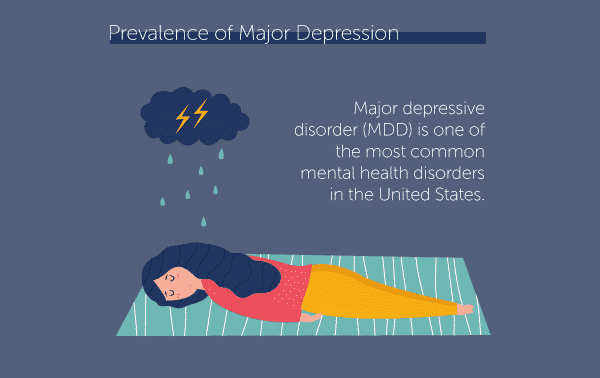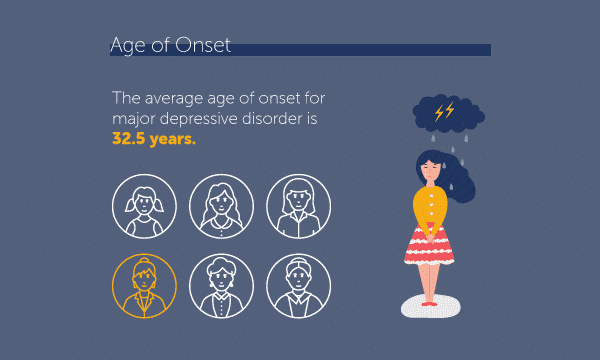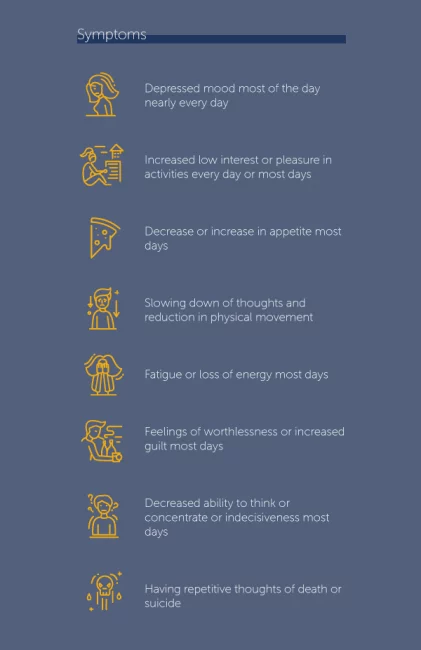Are you or a loved one living with major depressive disorder? The following facts and statistics explore the prevalence of this condition.
Several clinical studies have been conducted to determine major depressive disorder (MDD) statistics as seen in the American population. The information provided concerning MDD facts and statistics may change over time as research continues to be conducted.
Prevalence of Major Depression
Major depressive disorder (MDD) is one of the most common mental health disorders in the United States. A 2018 study reported that for a 12-month prevalence period, 10.4% of Americans had major depressive disorder, while 20.6% of Americans had a lifetime prevalence.
According to the Centers for Disease Control (CDC), between 2013 and 2016:
- Women were approximately twice as likely (10.4%) as men (5.5%) to have MDD
- Non-Hispanic adults had the lowest prevalence of major depression at (3.1%)
- African Americans had a prevalence of 9.2%
- The prevalence of depression increased as family income decreased. Approximately 15.8% of the U.S. population that were living below the federal poverty level were suffering from depression.
According to the World Health Organization (WHO), depression is the leading cause of disability worldwide, impacting 300 million people.

Age of Onset
Although major depressive disorder occurs more commonly in the adult population, major depressive disorder can occur at any age. According to the Anxiety and Depression Association of America, the average age of onset for major depressive disorder is 32.5 years.

Diagnosing Clinical Depression
Diagnosing clinical depression is based on the new fifth edition of the Diagnostic Statistical Manual (DSM-V). According to the DSM-V criteria, clinical depression is defined as having at least five or more symptoms for two weeks, with at least one of the signs being depressed mood or loss of interest.
The eight symptoms of clinical depression are:
- Depressed mood most of the day nearly every day
- Increased low interest or pleasure in activities every day or most days
- Increased weight loss or weight gain when not dieting, or a decrease or increase in appetite most days
- Slowing down of thoughts and reduction in physical movement
- Fatigue or loss of energy most days
- Feelings of worthlessness or increased guilt most days
- Decreased ability to think or concentrate or indecisiveness most days
- Having repetitive thoughts of death or suicide

Major Depressive Disorder and Related Conditions
Major depressive disorder is associated with several chronic conditions. Two major chronic diseases that people with MDD are often affected by are coronary heart disease and diabetes. According to one study, approximately 7 million Americans that have coronary heart disease also have major depressive disorder. The Agency for Healthcare Research and Quality indicated that 20% of people with major depressive disorder also had coronary heart disease. Another research study showed that people with depression were twice as likely to have diabetes compared to the general population.
Major depression can also co-occur with other psychiatric disorders. Anxiety and eating disorders are two of the most common mental health conditions that co-occur with MDD.
Anxiety
According to one study, about 51.2% of patients with depression also have anxiety. Approximately 75% of patients in primary health care settings live with both depression and anxiety.
Eating Disorders
According to the National Association of Anorexia Nervosa and Associated Disorders.
- Major depression and anorexia coexist 30–50% of the time
- Major depression and bulimia coexist about 50% of the time
- Major depression and binge eating disorder coexist 50% of the time
- Major depression and other specified feeding or eating disorders (OSFED) coexist approximately 50% of the time
Major Depression Suicide Rate
According to the World Federation of Mental Health, for every person who completes a suicide, at least 20 will attempt to end their life. Though the vast majority of people who attempt suicide do not complete the act, the associated risk of death from major depressive disorder is still dangerous by any standard.
Thankfully, treatment can help save these lives. According to the U.S. Department of Health and Human Services, there is a somewhat low likelihood that somebody that has depression will die from suicide if they receive proper treatment. Only 2% of people treated for depression in an outpatient setting will die from suicide. Those people treated in the inpatient setting are only twice as likely (4%) to die from suicide, generally because their depression is more severe.
Major Depressive Disorder Prognosis and Outlook
Major depressive disorder prognosis depends on factors such as relapse and remission. One study shows that 80% of patients will have a recurrent episode of depression. According to another article, depression is likely to be the second leading cause of disability worldwide by 2020. By 2030, depression is expected to be the leading cause of disability worldwide, according to the World Health Organization.
Related Topic: How long does depression last?
Statistics on Major Depressive Disorder Treatment
There are various forms of treatment for major depression. However, the choice of treatment for MDD depends on the severity of the disease.
Some of the most common treatments available for major depressive disorder include:
- Psychotherapy: There are various forms of psychotherapy, but the most common is cognitive-behavioral therapy (CBT), which is a form of therapy that attempts to help individuals cope with negative thoughts and emotions.
- Selective Serotonin Reuptake Inhibitors (SSRIs): These medications increase the amount of serotonin available in the brain by preventing serotonin (a chemical in the brain) from being recycled. The most common SSRIs used are fluoxetine (Prozac), sertraline (Zoloft), paroxetine (Paxil), citalopram (Celexa), or escitalopram (Lexapro).
- Serotonin and Norepinephrine Reuptake Inhibitors (SNRIs): SNRIs are the second-most commonly prescribed medications for MDD, after SSRIs. These medications increase the amount of serotonin and norepinephrine available in the brain by preventing them from being recycled. The most common SNRIs used are venlafaxine (Effexor), desvenlafaxine (Pristiq), or duloxetine (Cymbalta).
The best treatment for MDD depends on the individual and the severity of their condition. However, success is often seen when a combination of drug therapy and psychotherapy is used. A comprehensive study evaluated whether using SSRIs alone or using SSRIs with psychotherapy was better. The results indicated that using SSRIs with psychotherapy was better than using SSRIs alone. Another study found that using combined forms of psychotherapy with medications was only effective for the treatment of moderate to severe depression. However, for mild depression, using psychotherapy along with medications was not more effective than using psychotherapy alone.
If you or anybody you know has major depression and are suicidal:
- Call 1−800−273−TALK (8255) to reach the National Suicide Prevention Lifeline
- Call 911
- Perform mental health first aid
- Reach out to a friend or loved one
In many cases, people with MDD also live with co-occurring drug or alcohol abuse. If you’re ready to take the first step toward treatment for these conditions, The Recovery Village can help. Call The Recovery Village today to get started.


National Institute of Health. “Major Depression.” February 2019. Accessed April 17, 2019.
Kessler, Ronald. Berglund Patricia. Demlar, Olga; et al. “The Epidemiology of Major Depressive Disorder.” Journal of the American Medical Association, June 18, 2003. Accessed April 17, 2019.
Hasin, Deborah S. Sarvet Aaron S. Meyers Jacquelyn S; et al. “Epidemiology of Major Adult DSM – V De[…]n the United States.” Journal of the American Medical Association, April 2018. Accessed April 17, 2019.
Brody, Deborah. Pratt, Laura. Hughes, Jeffrey. “Prevalence of Depression Among Adults Ag[…]States, 2013–2016.” Centers for Disease Control and Prevention, February, 2018. Accessed April 17. 2019.
Anxiety and Depression Association of America. “Facts and Statistics.” Accessed April 17, 2019.
Tolentino, Julio. Schmidt Sergio. “DSM-5 Criteria and Depression Severity: […]r Clinical Practice.” Frontiers in Psychiatry, October 2, 2018. Accessed April 17, 2019.
National Institute of Mental Health. “Bipolar Disorder.” Accessed April 18, 2019.
National Association of Anorexia Nervosa and Associated Disorders. “Eating Disorder Statistics.” Accessed April 18, 2019.
Shelton, Jessica. “Depression Definition and DSM-5 Diagnostic Criteria.” Psycom, March 18, 2019. Accessed April 17, 2019.
American Psychiatric Association. “What is Depression?” January 2017. Accessed April 17, 2019.
Davidson, Karina. “Depression and Coronary Heart Disease.” International Scholarly Research Notices: Cardiology, November 22, 2012. Accessed April 17, 2019.
Agency for Healthcare Research and Quality. “Post-Myocardial Infarction Depression.” May, 2005. Accessed April 17, 2019.
Egede, Leonard. Zehng, Deyi. Simpson, Kit. “Comorbid Depression is Associated With I[…]iduals With Diabetes.” American Diabetes Association, March 2002. Accessed April 17, 2019.
U.S. Department of Health and Human Services. “Does depression increase the risk for suicide?” Accessed April 17, 2019.
Reddy, M.S. “The Disorder and the Burden.” Indian Journal of Psychological Medicine. Depression, June, 2010. Accessed April 17, 2019.
Holtheimer, Paul. Nemeroff, Charles. “Future Prospects in Depression Research.” Dialogues in Clinical Neuroscience, June, 2006. Accessed April 17, 2019.
National Alliance on Mental Illness. “Depression.” Accessed April 17, 2019.
Khan, Arif. Faucett, James. Lichtenberg Pesach. Kirsch, Irving. Brown, Walter. “A Systematic Review of Comparative Effic[…]trols for Depression. PLoS One, July 30, 2012. Accessed April 17, 2019.
Dematt, SM. Dekker J, Schoevers RA. de Jonghe F. “Relative efficacy of psychotherapy an[…]ion: a meta-analysis.” European Psychiatry: the journal of the Association of European Psychiatrists, December 26, 2007. Accessed April 18, 2019.
World Federation of Mental Health. “Depression a Global Crisis.” Accessed April 18, 2019.
American Society of Suicidality. “Depression and Suicide Risk.” Published 2014. Accessed April 18, 2019.
Hirschfeld, Robert. “The Comorbidity of Major Depression and […]ment in Primary Care.” Primary Care Companion to the Journal of Clinical Psychiatry, 2001. Accessed April 18, 2019.
The Recovery Village aims to improve the quality of life for people struggling with substance use or mental health disorder with fact-based content about the nature of behavioral health conditions, treatment options and their related outcomes. We publish material that is researched, cited, edited and reviewed by licensed medical professionals. The information we provide is not intended to be a substitute for professional medical advice, diagnosis or treatment. It should not be used in place of the advice of your physician or other qualified healthcare providers.
